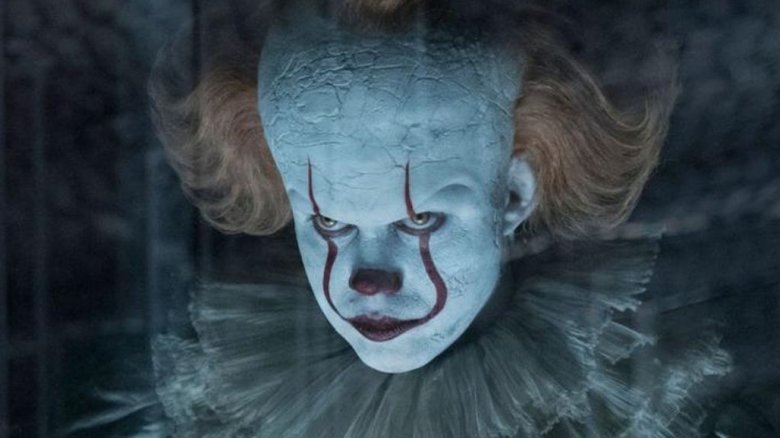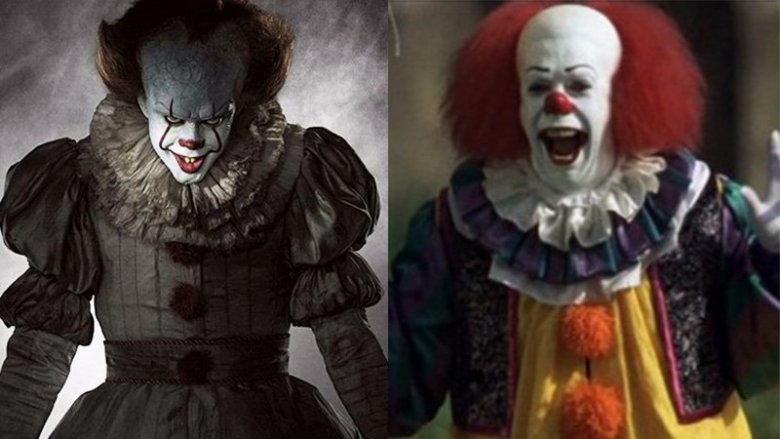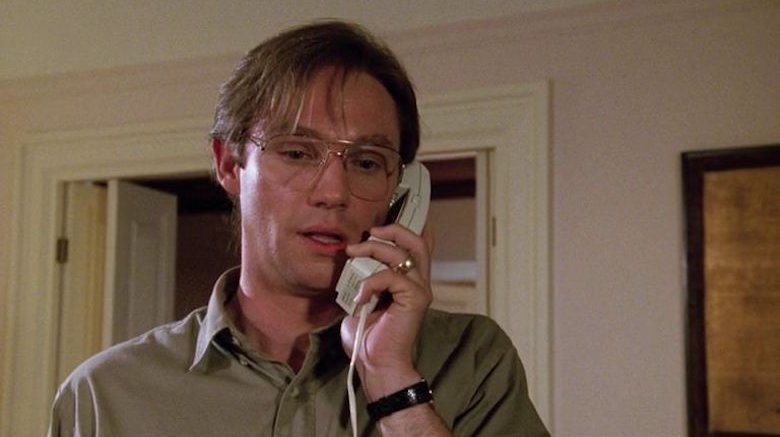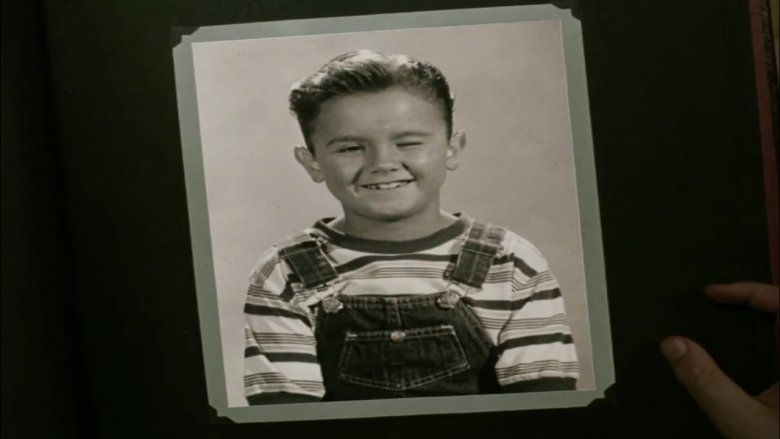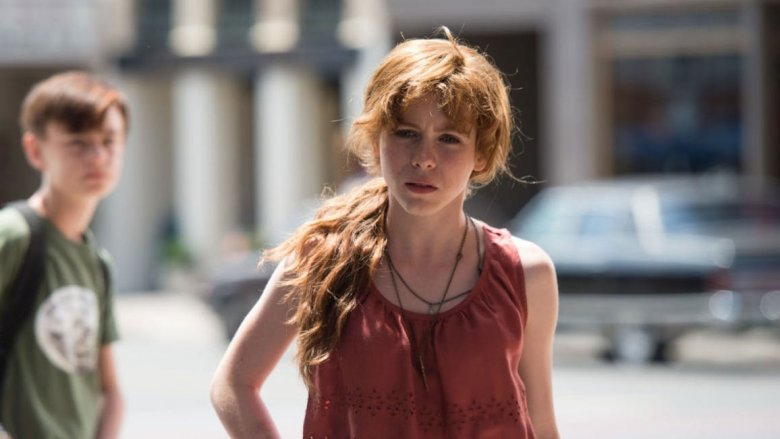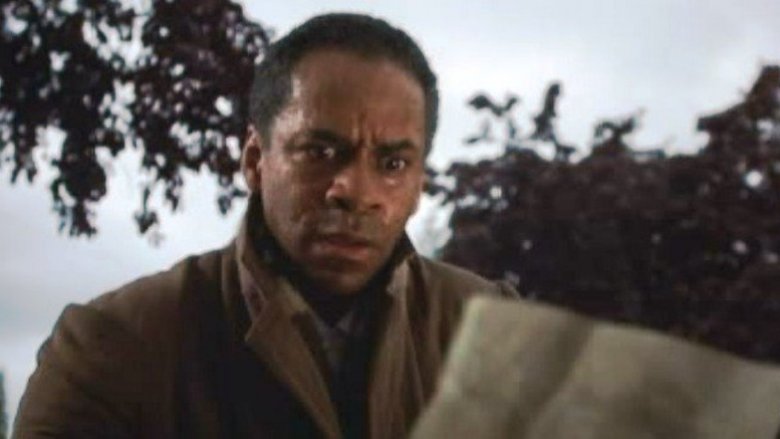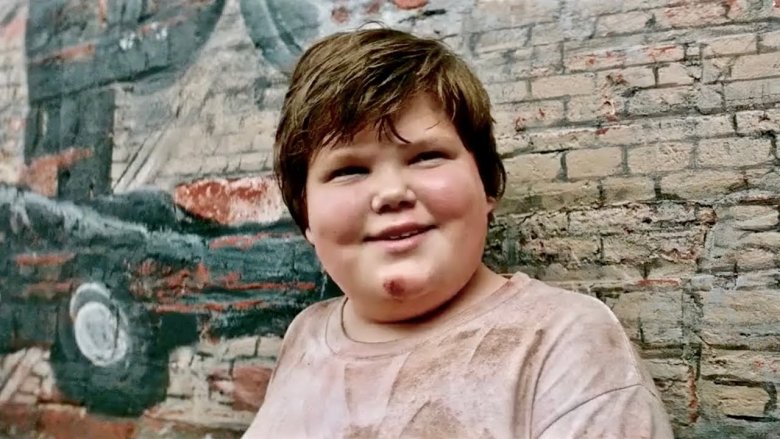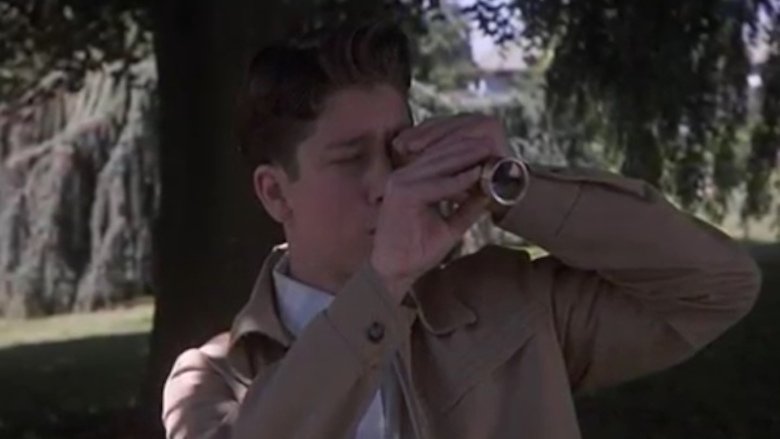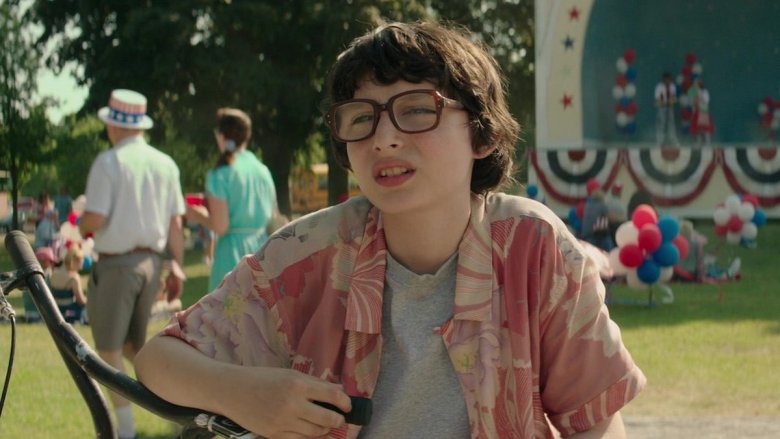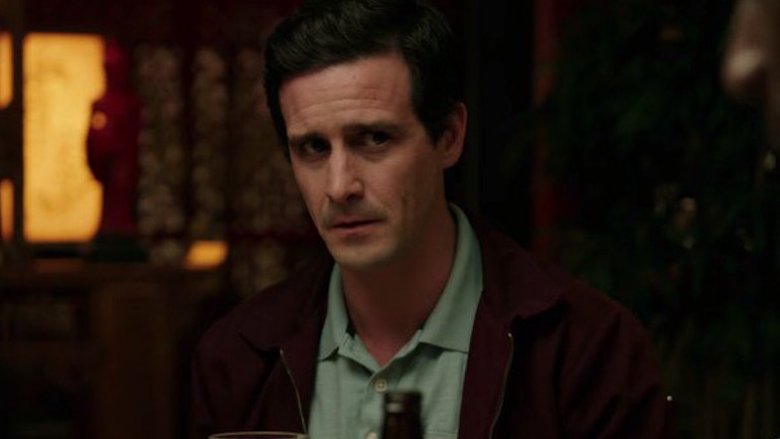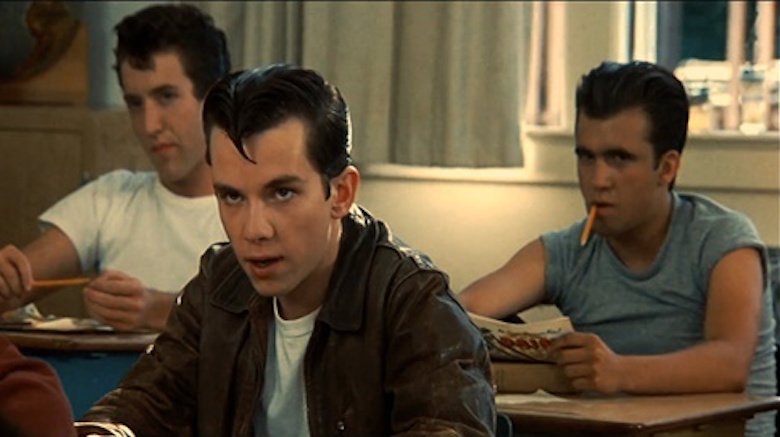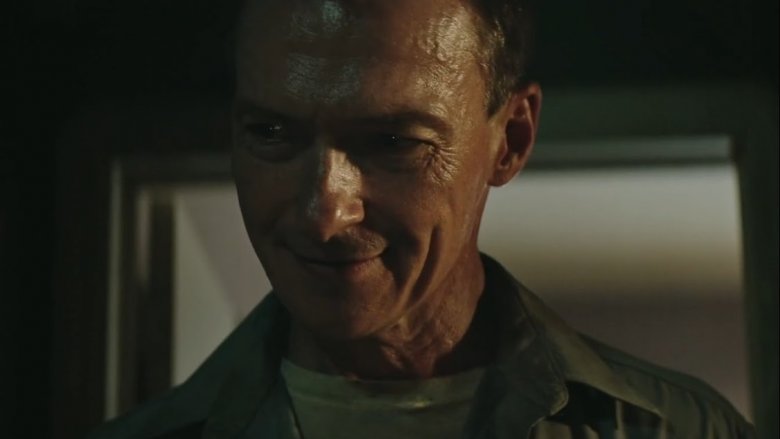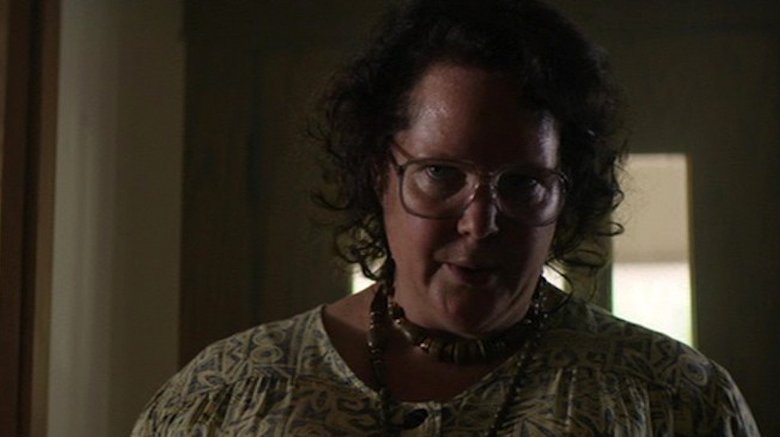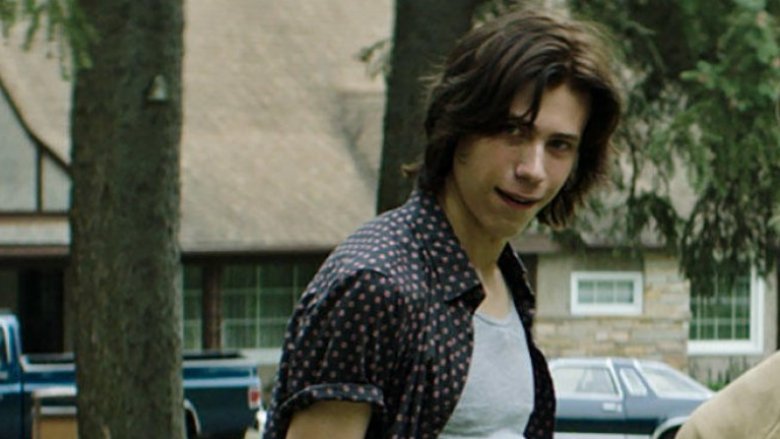How The Cast Of The It Movies Should Really Look
Stephen King's thousand-plus page opus It, the story of a killer clown who eats children, features dozens and dozens of characters in and around the imaginary town of Derry. As is customary for many of King's works, one of the ways he ramps up tension and stakes is by delving deep into the psyches and lives of even the most marginal characters so the reader gets more invested in the broader story. Of course, these narrative strategies on the page make visual adaptations of King's stories tricky, since there isn't enough time on screen to fully explore the rich worlds he has created or the inner lives of the characters within them.
While It easily has more than a hundred characters, each with their own weight and importance to the story, only a handful properly made it onto the screen via the 1990 It television miniseries or Andy Muschietti's 2017 and 2019 film adaptations. Pennywise himself has at least 15 different forms he takes on. So, how did Stephen King describe some of these main characters in his book? Float on down and have a look.
Pennywise
Which came first: the fear of clowns, or Stephen King's monstrous Pennywise? At this point it almost doesn't matter, since the two are so inextricably linked in the global consciousness and the nightmares of children and adults alike. During his first encounter with Georgie Denbrough in the sewer in 1957, Pennywise has yellow eyes that turn blue as he talks. King writes, " He looked like a cross between Bozo and Clarabell... The face of the clown in the stormdrain was white, there were funny tufts of red hair on either side of his bald head, and there was a big clown-like smile painted over his mouth. If George had been inhabiting a later year, he would have surely thought of Ronald McDonald."
King goes further: "He was wearing a baggy silk suit with great big orange buttons. A bright tie, electric-blue, flopped down his front, and on his hands were big white gloves, like the kind Mickey Mouse and Donald Duck always wore." That doesn't fit either screen version of Pennywise. When Ben Hanscom sees the clown shortly after, he is also wearing a "floppy yellow bow-tie" and notices that "the clown cast no shadow."
25 years later, when Pennywise attacks Adrian Mellon under the bridge, King reiterates the Bozo and Ronald McDonald comparisons, but adds that "later consideration had caused him to think the clown really looked like neither. The smile painted over the white pancake was red, not orange, and the eyes were a weird shiny silver." King also describes "great big teeth" like those of a circus lion.
Bill Denbrough
Also known as "Big Bill" and "Stuttering Bill," even to his friends, the unofficial leader of the Losers Club is described as having bright red hair and blue eyes. After the first attack on Pennywise in the house on Neibolt Street, Bill gives his shirt to Beverly. King writes that, when shirtless, Bill had "a narrow chest, the visible track of his ribs, [and] sunburned freckled shoulders." Young Bill also had an injury from his bike Silver, "a five-inch gash running between the wrist and elbow of his left arm." Even when they're young, Richie Tozier muses that John F. Kennedy reminds him of Bill.
Older Bill, as depicted in his author photo on the back of one of his novels, is described as "a bald man wearing glasses." King writes that "he is tall, and has a certain presence." Bill is "already balding, already inclining a bit toward fat. He speaks slowly in company, and at times seems nearly inarticulate" as a result of the stutter that began after he survived a terrible car accident at age three. "His eyes, magnified by the lenses of his glasses, looked thoughtful." That part lines up with how older Bill appears in the 1990 It miniseries, played by Richard Thomas. But what doesn't fit is "that red, fine hair that he had begun to lose when he was only a college sophomore." Thomas not only has hair, but enough of it to pull back into a ponytail.
Georgie Denbrough
While Pennywise the Clown had many, many victims detailed in the pages of King's It, the first we properly meet is Bill's little brother Georgie. His physical description is notably sparse — all we know at first is that Georgie is "a small boy in a yellow slicker and red galoshes," and he is just six years old.
Much later in the story, as Pennywise's campaign of terror begins ramping up against the Losers in earnest, King describes Georgie in more detail from a family photo album. "The final picture was George's school picture, taken in October of last year, less than ten days before he died. In it George was wearing a crew-neck shirt. His fly-away hair was slicked down with water. He was grinning, revealing two empty slots in which new teeth would never grow." As Pennywise uses Georgie's ghost to taunt Bill, he appears with his yellow slicker covered in blood, as well as his arm missing. Both movie adaptations of It end up faithfully portraying Bill's little brother, which was easy to do since he's described so ambiguously.
Beverly Marsh
Like Bill, Beverly has bright red hair that King's novel describes as auburn, coppery, and deep red, sometimes with blonde highlights, the "dim Irish fire of her hair." As a young girl her hair was shoulder length, and she wore it pulled back in a ponytail most of the time. Sometimes she braided it and tied it off with velvet bows. Beverly has "gray-blue eyes, naturally red lips, [and] creamy unblemished child's skin," with "a tiny spray of freckles across her nose." She has "small even teeth," a "sweet, slightly husky voice," and she's left-handed.
As a child, her wardrobe is described as cheap sweaters, penny loafers, and ill-fitting tartan skirts that "probably came from the Salvation Army thrift-box." She also sports "low-topped sneakers" and a "bright golden ankle bracelet" on her right foot. Beverly often has huge bruises on her face and arms that fade from purple into yellow before disappearing and reappearing again — the signature of her father's abusive handiwork. She had a "feline, lynxlike" posture "of total attention and concentration." Ben recalls: "Except for the color of her hair, [Ben] thought that Bev looked like Marilyn Monroe."
As an adult, Beverly is described as a "gorgeous woman" with a slim but well-endowed figure. She's grown her red hair down to her waist and her fingernails are "kept neat but brutally short." Shades of these descriptors are evident in all of Beverly's portrayals on screen, except for the short nails.
Mike Hanlon
As a young man, the Losers' — and Derry's — lighthouse keeper Mike Hanlon is described as "slim and well built" as well as "fast and agile," factors that had saved him from several beatings at Henry Bowers' hands." Mike has "dark skin" and a "tight cap of hair," often wearing "corduroys, a tee-shirt, and black high-topped Keds."
Bill's assessment of Mike when he returns to Derry reveals the extended trauma Mike has survived by remaining in the haunted town. "[Bill] remembered a boy who had been about five feet three, trim, and agile. Before him was a man who stood about five-seven. He was skinny. His clothes seemed to hang on him. And the lines in his face said he was on the darker side of forty instead of only thirty-eight or so... [Mike] smiled then and the smile lit his face. In it Bill saw the boy he had known twenty-seven years ago." Even so, "There were wrinkles in [Mike's] forehead, lines had grooved themselves from the corners of his mouth nearly to his chin, and his hair was graying on both sides." Mike also wears glasses as an adult, and he has a scar across his chest from when the werewolf form of Pennywise scratched him at Neibolt Street.
The cab driver who drops Bill off at his hotel in the later years describes Mike very simply: "Librarian. Black fella." Mike and his family were the only remaining black folks in Derry, both when he was young and as an adult. His portrayal on screen in the 1990 miniseries is truer to the book than the Muschietti movies, where Chapter One gives much of his motivation to Ben Hanscom and Chapter Two has him hit harder by the trauma of his youth.
Ben Hanscom
As a child, Ben Hanscom was described as larger than any of the It adaptations have shown. King's hyperbolic description paints him as "an eleven-year-old kid with a can roughly the size of New Mexico — said can packed into a pair of horrid new blue jeans that shone little darts of light from the copper rivets and went whssht-whssht-whssht as his big thighs brushed together. His hips swung girlishly. His stomach slid from side to side... He almost always wore baggy sweatshirts because he was deeply ashamed of his chest." The boys at school bully him for having "breasts." Ben had four baggy sweatshirts in which to drown his 210-pound body; one brown, one green, and two blue. He wore Keds and had a "cowlick at the back of his head, springing back and forth like a Slinky."
Older Ben couldn't be more the opposite of his younger self. King writes that Ben is "lanky, sunburned, dressed in a chambray shirt, faded jeans, and a pair of scuffed engineer boots," with "faint squint lines around the corners of his eyes, but nowhere else." In contrast to his fellow Losers who wear the psychological tolls of their trauma on their faces, Ben looks "perhaps ten years younger than his actual age, which was 38."
When the grown-up Losers meet in Derry for dinner, King describes: "[Ben's] face was the same, and his hair, although graying and longer, was combed in the same unusual right-side part. But Ben had gotten thin. [His] clothes clung to a body which was slim and narrow-hipped. He wore a bracelet with heavy links on one wrist — not gold links but copper ones." Jay Ryan as older Ben in Chapter Two fits this bill far more than John Ritter did in the 1990 miniseries.
Stanley Uris
Young Stanley doesn't give even a small hint as to how tragically his story will end. King writes, "As always he looked small, slim, and preternaturally neat — much too neat for a kid who was barely eleven. In his white shirt, neatly tucked into his fresh jeans all the way around, his hair combed, the toes of his high-top Keds spotlessly clean, he looked instead like the world's smallest adult. Then he smiled, and the illusion was broken." Stan often wears a slicker, and carries his bird book and binoculars with him. "He was a fastidious boy," King says.
In the brief time we have with older Stan before he kills himself, his wife describes him as "ropy with muscle" with "a hipshot way of walking, a taste for bell-bottomed jeans on his days off, and the last ghosts of adolescent acne still on his face." He keeps his black hair short and, like many of the other Losers, wears glasses as an adult. There are shades of this version in Andy Bean's Stanley in It: Chapter Two, but almost none at all in the 1990 miniseries, in which Stan was played by Richard Masur.
Richie Tozier
Like Georgie Denbrough, the physical description of Richie "Trashmouth" Tozier is surprisingly bare in the It novel, considering he is one of the key seven characters. King writes, "Tozier was a scrawny kid who wore glasses... His magnified eyes swam behind the thick lenses with an expression of perpetual surprise. He also had huge front teeth that earned him the nickname Bucky Beaver." His glasses were held together with Red Cross tape.
Even older Ritchie only reflects on his appearance about his younger self when he looks in the mirror: "He saw a boy who wore glasses, a thin boy with a pale face that had somehow seemed to scream Hit me! Go on and hit me! ... Here are my eyes so blue and magnified behind these hateful, hateful glasses, these horn-rimmed specs one bow of which is held on with adhesive tape." Older Richie trades his glasses for contacts, until he returns to Derry and Pennywise starts messing with his eyes. But by then he's no longer the odd duck out of the Losers Club with specs; most of the other Losers wear glasses too. One major on-screen difference is that in It: Chapter Two, Bill Hader's Richie is still wearing his horn-rimmed glasses — except by choice.
Eddie Kaspbrak
Thanks to his mother's undiagnosed Munchausen by Proxy syndrome that constantly has Eddie in and out of the emergency room, the young boy's face is described as "small and pinched and worried — an old man's face." Young Eddie has a "shy smile... incredibly sweet and almost heartbreakingly vulnerable" with "flecks of gray" in his eyes that seem to move around when he's upset or angry. Eddie carries an aspirator for his asthma.
Aging doesn't do Eddie many favors at all. King describes adult Eddie as "a short man with a timid, rabbity sort of face. Much of his hair was gone; what was left grew in listless, piebald patches ... there was a little snow on Eddie's mountain already."
Big Bill's assessment of Eddie is harsh indeed. "Eddie... had grown up to look quite a little bit like Anthony Perkins. His face was prematurely lined... and made older still by the rimless spectacles he wore... His hair was short, worn in an out-of-date style that had been known as Ivy League in the late fifties and early sixties. He was wearing a loud checked sportcoat... but the watch on one wrist was Patek Philippe, and the ring on the little finger of his right hand was a ruby. The stone was too hugely vulgar and too ostentatious to be anything but real."
In short, Eddie on screen has never looked much like the character on the page.
Henry Bowers
Pennywise was not the Losers' only nemesis. That unfortunate honor also goes to Henry Bowers, about whom King writes, "Henry was a big boy even for twelve. His arms and legs were thick with farm muscle... Henry put in at least thirty hours a week hoeing, weeding, planting, digging rocks, cutting wood, and reaping."
He continues, "Henry's hair was cut in an angry-looking flattop short enough for the white of his scalp to show through. He Butch-Waxed the front with a tube he always carried in the hip pocket of his jeans, and as a result the hair just above his forehead looked like the teeth of an oncoming power-mower." Interestingly, Bowers typically wears "a pink motorcycle jacket with an eagle on the back" — a pink jacket that nobody ever mentions because the one person who did got beat so badly Henry put him in the hospital. Henry has black eyes that sparkle, especially when committing violence. He sports "motorhuckle boots," the back of his head has a cowlick, and like Beverly, often comes to school with bruises from his father's beatings.
Years later, as King writes, "The light fell on the face of Henry Bowers. It had grown fat, the skin had an unhealthy tallowy hue; sagging; the cheeks had become hanging jowls that were specked with stubble, almost as much white in that stubble as black. The eyes were small and mean inside discolored pouches of flesh — bloodshot and thoughtless... His lips parted in an unspeakable grin, revealing rotted back-Maine teeth." In the 1990 adaptation, Henry's hair has turned white from the trauma of encountering Pennywise. But in the Muschietti adaptations, older Henry does resemble the description in King's novel.
Mr. Marsh
For Beverly Marsh, the terrors of Derry begin right in the discomfort of her own home, thanks to her abusive father, Alvin Marsh. "There her father stood, a big man who was now losing the red-auburn hair he had passed on to Beverly," King writes. "He was still wearing his gray fatigue pants and his gray shirt (he was a janitor at the Derry Home Hospital)." He has bushy eyebrows, and a certain way of standing: "bent slightly forward, hands plunged deep... in his pockets, the bright blue eyes in his mournful basset-hound's face looking down at her from above."
Mr. Marsh is left-handed, a trait he's passed onto his daughter along with the freckles on his arms. To work he sometimes wears khaki pants and a shirt "with two flap pockets, a keyring attached to his belt by a chain" and high-top shoes.
He has a "slightly grizzled face," but it's often described in ways as terrifying as Pennywise's various visages. Beverly observes, "There was concern on his face but it was a predatory concern, somehow more frightening than comforting." It is this detail about Mr. Marsh that comes across perfectly in both the It miniseries and the movies through the chilling work of actors Frank C. Turner and Stephen Bogaert, respectively.
Mrs. Kaspbrak (and Myra Kaspbrak)
One of the features that links many of the characters in It is an abusive home life, and Eddie Kaspbrak's is no exception. He's raised by his single mom, who is described as "a huge woman. Her legs, encased in Support hose, were trunklike but weirdly smooth. Her face was pale now except for hectic flaring blots of rouge."
After Henry breaks Eddie's arm and he's in the hospital getting the cast, King writes, "[Eddie] looked at his mother, seeing her clear in his pain: each flower on her Lane Bryant dress, the sweat-stains under her arms where the pads she wore had soaked through, the scuff-marks on her shoes. He saw how small her eyes were in their pockets of flesh... those eyes were almost predatory, like the eyes of the leper that had crawled out of the basement at 29 Neibolt Street."
The adult Eddie, as we learn in the novel, "did not need a shrink to tell him that he had, in a sense, married his mother. Myra Kaspbrak was huge. She had only been big when Eddie married her five years ago, but sometimes thought his subconscious had seen the potential for hugeness in her; God knew his own mother had been a whopper." In fact, when older Eddie puts their photos next to each other he finds that "[Mrs. Kaspbrak and Myra] could have been sisters." Andy Muschietti's It Chapter Two cleverly casts the same actress, Molly Atkinson, for both roles.
Patrick Hockstetter
There are many human monsters in King's novel, and Patrick Hockstetter is no exception. While Henry Bowers leads a whole team of violent bullies, the only one Stephen King classifies as an actual psychopath is Patrick, who murdered his baby brother because he cried too much. King describes Hockstetter as "a genuinely spooky kid... just enough overweight so that his belly always hung slightly over his belt, which had a Red Ryder buckle. His face was perfectly round, and usually pale as cream. Now he had a slight sunburn. It was heaviest on his nose, which was peeling, but it spread out toward either cheek like wings." King says, "He wasn't as fat as Ben, but he was podgy."
Patrick kills flies and collects them in a pencil box, "his heavy lips smiling, his gray-green eyes sober and thoughtful." He has a "low, husky voice" and grins with "big rubbery lips" as he sexually assaults his classmates, groping any girl within arm's length. When participating in violence, Patrick Hockstetter has a "porky vacant" expression, "smiling his liverish unsettling smile." He has a "slack and pallid moonface" that is the opposite of actor Owen Teague's angular visage, expressive eyes, and lanky frame in It: Chapter One. Patrick's dull expression changes only once in the book: to fear when Pennywise eats him. In the novel, Patrick is 12 years old; the film suggests he is in his mid-teens.
